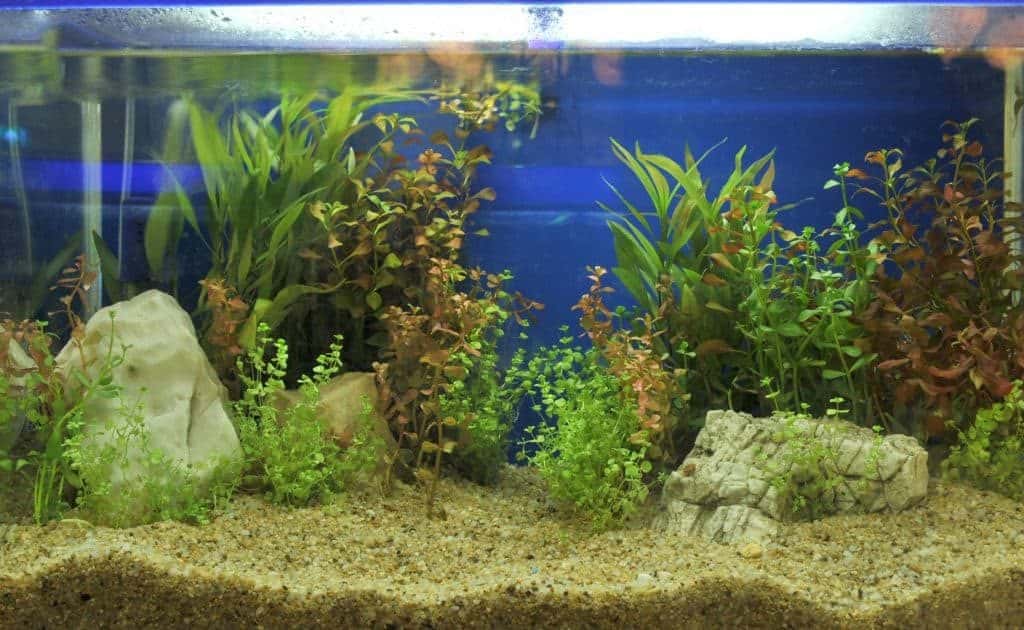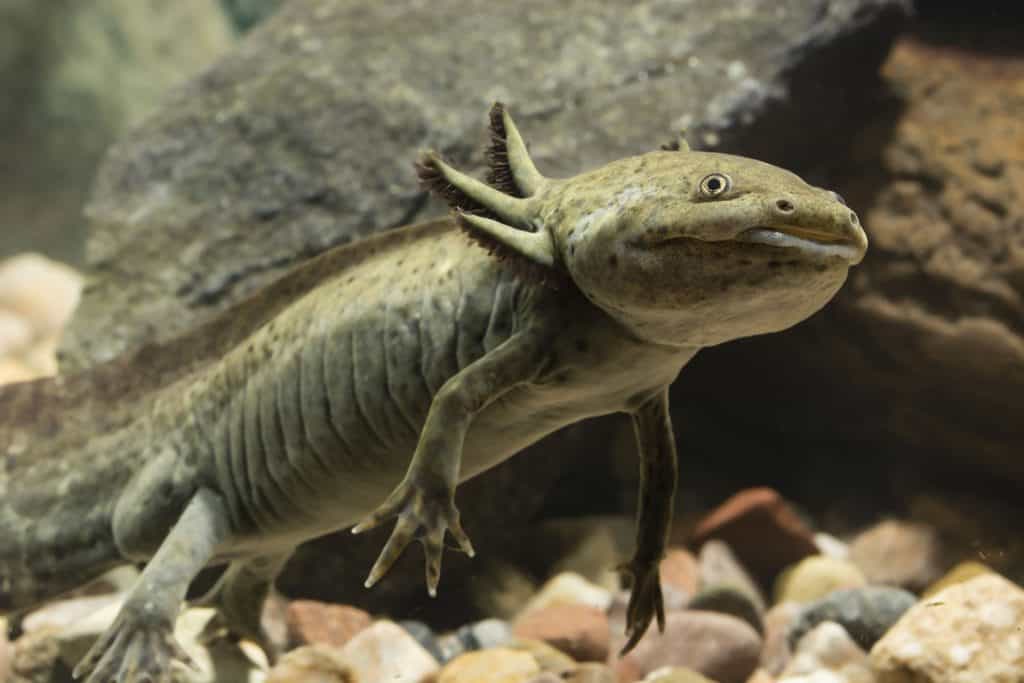What is the Right Tank Size For an Axolotl?

If you are a beginning Axolotl Owner, or student learning about animals like I am, then you probably have wondered what size tank is right for your Axolotl. Having owned fish before, I have wondered how different an Axolotl tank can be. Turns out, they can be pretty similar.
What is the right tank size for an Axolotl?
Axolotl tanks should be no less than two feet in length. These tanks should be wider than they are tall, as Axolotls prefer to explore around the bottom of their tank, or even just chill and float around very top of the water in their tank.
If you are planning on setting up an Axolotl tank, there are a few thing that you should know before you do.
Setting Up (What to Include)
As I mentioned before, Axolotls prefer to have room to roam around the bottom of their tanks. Because of this, you want to give your Axolotl the space he/she needs. Adult Axolotls get up to about a foot in length, so at the bare minimum, you want to give your Axolotl at least a 2-foot long tank.
When purchasing your tank, you need to remember that you not only need room for your Axolotl but room for decorations as well.
You will find that Axolotls like the dark, so they will be much happier in a tank that will provide them with places to sit and hide. Whether this is plants or other hidey holes, this is a key essential to keeping your Axolotls happy.
Beware when including live plants in your tank! Axolotls will often uproot and sometimes even squash plants in their tank. This isn’t because they don’t like the plants being there, your Axolotl is just trying to use the plant as a place to rest.
It is also not essential for you to fill your tank up the whole way like you would with a fish. Mainly because your Axolotl really will spend most of his or her time at the bottom of the tank.
Deciding whether or not to include gravel at the bottom of your tank is entirely up to you. However, most Axolotl owners do not like to include gravel in case the Axolotl swallows it and develops Impaction.
If you want to include a substrate for your Axolotl, I would recommend using fine sand over gravel. Or just go with a bare bottom.
Taking Care of the Tank

Before you buy your Axolotl, you need to keep in mind that these animals are messy! This means that if you want one, you need to be willing to put in the time and effort to maintain and upkeep a clean tank to keep your Axolotl happy.
The first two things you need to buy alongside your tank would be a water filter and a thermometer.
For Axolotls, you will want to use a filter that has low flow. If your filter has a strong current, it will stress out your Axolotl. Here are the top 3 suggestions I was able to find for beginning Axolotl owners to use when filtering their tanks
- Sponge Filters (Although you will need a really big sponge)
- Hang-On-Back Filters (Only part of it goes in the tank)
- Canister Filters
The easiest to of these filters to manage for a beginner is probably a Hang-On-Back filter. These filters will take up the least amount of room in your tank and will be the easiest for you to clean. And you can even include a sponge in there to help with the filtration.
Your Axolotl will be very unhappy if you keep the temperature in its tank to high. Axolotls are native to Mountainous Area in Mexico where the temperature of the water stays cool during the day.
You should be keeping your Axolotl’s water temperature at a range of 60-68 degrees. Make sure you use a thermometer to keep track of the water’s temperature.
pH is a big deal when it comes to keeping any aquatic pet. And for Axolotls, this is no different. You should be keeping the pH of your pet’s water at about 6 and-a-half to 8 on the pH scale.
Alongside filtration, it is also important that you do weekly water changes in your Axolotl’s tank to get rid of any mess or waste that your filter was not able to take out of the water. Just be sure to check on the temp. and pH of the water as you are changing it.
Can I Put Other Animals in the Tank With My Axolotl?
Axolotls do much better in tanks that include their own species. If you are thinking of including fish in the tank with your Axolotl, it may be best to rethink this decision.
It has been discovered by many Axolotl owners that when they included fish in their tank, one of two things would happen…
Either the fish would nibble on the Axolotl’s gills, or the Axolotl would eat the fish!
It wouldn’t necessarily be a bad thing to include some feeder animals in with your Axolotl if your intention is to eventually have your Axolotl eat his tankmates.
However, Buyer Beware! Axolotls 6 inches and under have been known to eat other Axolotls that have been in the tanks with them! In other words, it is possible for your smaller Axolotls to become Cannibalistic!
Things to Look Out For
Maintaining Your Tank
If you are not regularly changing your Axolotl’s water, they can very easily become sick and stressed. You may start to notice fungus growing in your Axolotl’s gills. This is a good sign that you are not taking proper care of your Axolotl tank.
To prevent this from happening, make sure you are doing each of the following
- Weekly Water Changes
- Cleaning Out the Filter
- Maintaining a Reasonable pH
- Maintain low Ammonia and Nitrate Levels
Regeneration
One of the most amazing things about Axolotls is that they have been known to regenerate limbs and sometimes even vital organs.
In fact, Axolotls can teach us a lot about the human body through their regenerative powers. However, you should be especially careful if you notice any aggression in your Axolotls.
Make sure if you are keeping more than one Axolotl in a tank that you are keeping them on a regular feeding schedule. Axolotls can easily mistake the limbs of another Axolotl as their next meal. This mistake may cost one of your Axolotls their life if not caught quickly and too much blood is lost.
Keeping the Tank Cool
Axolotls can easily overheat during the warmer months if you are not regularly checking their water temperature. Keep in mind that these animals are native to mountain lakes, so they prefer to be in colder water.
If you notice that your Axolotl has started to develop white patches on its skin, then he or she is probably a bit stressed as well as overheated. You need to start lowering the temperature in the water.
Some people use fans to help chill the water in their Axolotl tanks when the weather starts to get warmer.
You may also be able to find a cheap chilling system for you aquarium in order to prevent future overheating.
Related Questions:
Are Axolotls hard to care for?
Axolotls are relatively easy pets to care for. As long as you have a good filter and are treating their water with water conditioner, they should be able to live a happy life. Also, make sure you are doing frequent water changes throughout the week. Please take care when checking your Axolotl’s water.
How many liters does an Axolotl need?
For Axolotls, there is no set number of liters that are set in stone. However, from what I have come to understand, the general Rule of Thumb with Axolotls is that you need about 30 liters of water per adult Axolotl.
Can you take an Axolotl out of the water?
Definitely not! Taking your Axolotls out of the water may cost them their lives! Axolotls are amphibians and entirely water-dwelling animals. In some very rare cases, your Axolotl may metamorphose and become land-dwelling. But as a general rule, keep your Axolotl in the water!
